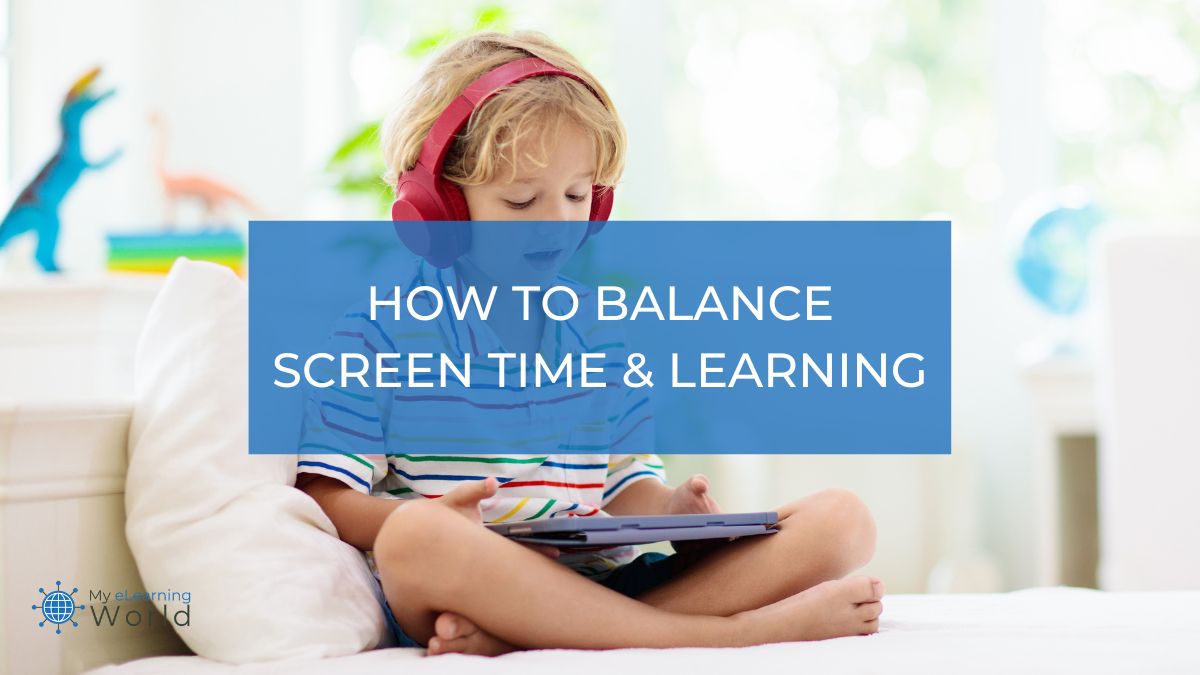According to the CDC, the average kid now spends nearly 8 hours a day in front of a screen, and the vast majority of that time is spent with pure entertainment. As a longtime teacher, I’ve dealt with the battle of balancing screen time with effective learning firsthand. It’s a constant challenge, but over the years, I’ve discovered a number of practical strategies that are successful in navigating this balance.
Technology is now an integral part of education and our every day lives. There’s no way around that. No way to unring that bell. That’s why it’s crucial to find ways to use screens wisely, ensuring they enhance rather than hinder the learning process. From setting clear boundaries to choosing quality educational content, I’ll explore how to make screen time a valuable component of your child’s educational journey.
Choose The Right Apps
 HOMER - The Essential Early Learning Program and App for Kids 2-8
HOMER - The Essential Early Learning Program and App for Kids 2-8
HOMER is a personalized learning app designed to help kids fall in love with learning. There are over 1,000 learning activities across all subjects, and the content is tailored to your child's age and interests.
Not all screen time is created equal, and not all apps and games offer educational value. To make the most of screen time, you’ll want to carefully curate the apps and games your children use. Look for apps that combine entertainment with learning, like HOMER and codeSpark, to name a couple of my favorites.
HOMER and codeSpark both offer a wide variety of interactive games and activities that stimulate a child’s cognitive and social development, making learning enjoyable. Both apps tailor the learning experience to the child’s level, and encourage critical thinking every step of the way.
Using high-quality educational apps and games is the right way for parents to ensure that screen time is fun and beneficial for their child’s growth and development.
You should also consider your child’s age and developmental stage when choosing apps. Age-appropriate content ensures that your child can engage with the material effectively and stay motivated.
Additionally, I highly recommend regularly reviewing and updating the apps on your child’s device to keep the learning experience fresh and exciting.
By making thoughtful choices about educational apps and games, parents can provide their children with valuable opportunities for growth while enjoying their screen time. You can kill two birds with one stone by giving your children the knowledge they need and promoting responsible screen use.
Establish Screen Time Limits
Setting screen time limits is important for managing your child’s digital activities. These limits should be both clear and reasonable, taking into account your child’s age, school schedule, and other responsibilities.
Collaborate with your child to create a screen schedule that allocates time for educational use, such as homework or learning apps (like HOMER and codeSpark), as well as recreational activities.
Breaks between screen sessions are essential to prevent prolonged exposure to screens. Encourage your child to engage in physical activities, read books, or pursue creative hobbies during these breaks. Always encourage and promote a healthy balance between screen time and other essential aspects of life.
Reward-based systems can also be effective in teaching responsible screen use. Offer additional screen time as a reward for completing chores or homework or for exhibiting good behavior. This approach helps children understand that screen time is a privilege to be earned through responsible actions, reinforcing the concept of balance and responsibility.
Become A Role Model
Children often learn by watching those around them, particularly their parents. If you’re constantly glued to your device, they’ll want to do the same.
When you demonstrate balanced and responsible screen time habits, you provide a tangible example for your child to follow. Your consistent adherence to screen time boundaries and responsible online behavior sends a clear message about the importance of mindful technology use.
Your role modeling can help instill healthy screen time habits in your child from a young age. By setting limits on your screen use, particularly during family meals and quality time, you teach your child the significance of real-world interactions and the value of being present in the moment. This establishes the foundation for them to develop balanced technology habits that prioritize both online and offline experiences.
Teaching responsible screen time through role modeling equips your child with a valuable life skill. As they grow and navigate an increasingly digital world, the lessons they learn from your example will guide them in making the right call concerning technology use. You should always be helping your children develop a strong foundation for a healthy and balanced relationship with technology throughout their lives.
Co-Viewing & Supervision
I’ve found that co-viewing and discussing screen content with your child can greatly enhance the learning experience. I recommend that you sit down with your child and watch educational programs or play educational games together. While doing so, encourage active participation by asking questions, fostering discussions, and providing context to deepen your child’s understanding.
Co-viewing allows parents to monitor the quality of content and provides an opportunity to address any questions or concerns that may arise during screen time. It fosters a sense of shared learning and exploration, strengthening the parent-child bond. Additionally, by engaging in co-viewing, parents can identify any areas of interest or passion that their child may have, allowing them to tailor future screen time experiences to align with these interests.
The discussion after co-viewing can be just as valuable as the viewing experience itself. Encourage your child to reflect on what they’ve learned, share their thoughts, and ask questions. This post-screen time dialogue not only reinforces learning but also encourages critical thinking and curiosity.
When To Avoid Screens
As an educator, I always advise against screen time before bed to promote healthy sleep habits in children. The blue light from screens can interfere with the body’s melatonin production, a key hormone in regulating sleep. Allowing kids to use screens too close to bedtime can disrupt their ability to fall and stay asleep, impacting their overall well-being and ability to focus in class.
Encourage your child to unwind during the day with calming activities like reading a book. The absence of screens during this time helps signal to the body that it’s time to prepare for sleep.
Quality sleep is essential for a child’s physical and cognitive development, as it supports memory consolidation and emotional regulation. By avoiding screen time in the hour leading up to bedtime, parents can contribute to their children’s overall well-being and ensure they wake up refreshed and ready to learn.
Manage Expectations
Managing expectations for technology is essential for both parents and children. You have to recognize that, while technology can be a powerful educational tool, it is not a replacement for hands-on learning experiences and real-world interactions. Parents should maintain realistic expectations of what technology can achieve and integrate it into a broader educational strategy.
As a teacher, I believe it’s important that technology serves as a supplement, not a substitute, for traditional learning methods. I encourage parents to foster a balanced approach that includes both digital and offline activities. This balance is key to ensuring children receive a holistic education, developing critical skills like problem-solving, social interaction, and creativity.
It’s also essential to set reasonable screen time limits and establish rules for proper online conduct. Having open conversations with children about their technology use is crucial. Discussing responsible screen usage, the risks of too much screen time, and the importance of online privacy and security can help guide them towards healthy digital habits.
Managing expectations of technology lets parents harness its benefits while avoiding the pitfalls of over-reliance. Technology can be a powerful educational ally when used wisely, fostering curiosity, providing access to a wealth of information, and enhancing learning experiences. However, it’s essential to maintain a balanced perspective and prioritize a holistic approach to education that includes both digital and real-world experiences.
Final Thoughts
We’re all so busy these days that balancing screen time and learning isn’t always an easy task. It takes dedicated effort and thoughtful parenting to navigate this aspect of your child’s life, rather than simply using a device as a quick fix for difficult moments.
These tips are designed to help you establish a healthy approach to screen time for your child. Remember, it’s not about completely cutting out screen use, but rather about using it smartly to complement education and boost cognitive development.
Have any questions about helping balance screen time and learning for your kid? Let me know by leaving a comment below.


